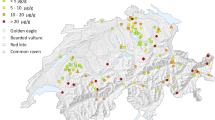Abstract
The effects of sublethal concentrations of lead nitrate on the terrestrial isopod Porcellio laevis were studied experimentally under controlled conditions over a period of 8 weeks. Changes in body mass were recorded. Avoidance-behaviour studies were undertaken to determine whether P. laevis can detect and possibly avoid lead in the environment. P. laevis was affected negatively by the presence of lead nitrate and showed a loss in body mass. More than 86% of the total body burden of lead was compartmentalized in the hepatopancreas. The isopods were capable of avoiding leaves contaminated with 200 mg kg–1 lead nitrate in behavioural tests but did not avoid leaves contaminated with a higher concentration.
Similar content being viewed by others
Author information
Authors and Affiliations
Additional information
Received: 10 March 1998
Rights and permissions
About this article
Cite this article
Odendaal, J., Reinecke, A. The toxicity of sublethal lead concentrations for the woodlouse, Porcellio laevis (Crustacea, Isopoda). Biol Fertil Soils 29, 146–151 (1999). https://doi.org/10.1007/s003740050537
Issue Date:
DOI: https://doi.org/10.1007/s003740050537




